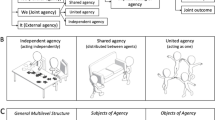Abstract
This paper argues that the intentional actions of collective entities, such as corporations and agencies, are not necessarily joint intentional actions by several members of those collectives. I briefly summarize the social action theories of John Searle, Michael Bratman, Margaret Gilbert, Raimo Tuomela, and Seumas Miller, which I argue are all theories of joint action. I then describe a case based loosely on events from the 2008 financial crisis in which an intentional collective action is performed by a corporation due to the actions of two employees who have no knowledge of one another, and therefore cannot be engaged in a joint intentional action. I argue that this shows that, contrary to what joint action theorists are committed to, every intentional collective action does not entail the existence of a joint intentional action. Finally, I suggest that we should look for a weaker notion of coordination than that employed by joint action theories, and that this might be provided by examining the command structures of organizations.
Similar content being viewed by others
Notes
Gilbert (1989), p 197, “Ajoint action will occur if and only if each of X, Y, and Z acts in the light of their joint espousal of the goal in question (emphasis in original).”
Gilbert (1996), pp 177–194.
Bratman (1999), pp 93–108.
Searle (2010), p 47.
This seems to me to be the best interpretation of Gilbert’s theory, although other readings seem to be possible. Specifically, it is not absolutely clear to me whether Gilbert’s account requires that for every individual action by a plural subject, all of the individual members be jointly committed to performing that particular action as a body. Her simple paradigm cases, such as the activity of walking together and the case of the poetry discussion group in Gilbert (1996), pp 177–213 seem to suggest that common knowledge of the plural subject’s commitments is a requirement for the constitution of a plural subject. For example, when Jack and Sue go for a walk together, Gilbert thinks that both of them believe that they form a plural subject which has the intention of going for a walk. However, given that Gilbert believes that our everyday concepts of social groups are plural subject concepts, it could be that she requires common knowledge of the commitments of the plural subjects only for the initial constitution of a collective, and that, once constituted, all the collective intentional states of the plural subject need not be known to every member. If so, my argument would not be an objection against Gilbert’s account on the whole, although it would point out that more needs to be said to bridge the gap between plural subjects of individual actions and robust and persisting collective agents.
Bratman (1999), p 121.
Tuomela (2013), p 27.
Tuomela (2013), p 163.
Miller (2001), 160ff.
For reporting on a similar actual case, see This American Life, “Episode 405: Inside Job.” Accessible at http://www.thisamericanlife.org/radio-archives/episode/405/inside-job.
Gilbert (2006), p 146.
Tuomela (2013). p 163.
Bratman (2014), p 151.
Miller, p 180.
See, for example, Searle (1995), p 25.
References
Bratman, M. (1999). Faces of intention: Selected essays on intention and agency. Cambridge: Cambridge University Press.
Bratman, M. (2014). Shared agency: A Planning theory of acting together. Oxford: Oxford University Press.
French, P. (1979). The Corporation as a moral person. American Philosophical Quarterly, 16(3), 207–215.
Gilbert, M. (1989). On social facts. Princeton: Princeton University Press.
Gilbert, M. (1996). Living together: Rationality, sociality, and obligation. Lanham, MD: Rowman & Littlefield.
Gilbert, M. (2006). A theory of political obligation. Oxford: Oxford University Press.
Krauss, C., & Schwartz, J. (2012). BP will plead guilty and pay over \(4{\$}\) billion. The New York Times. November 15, 2012.
List, C., & Pettit, P. (2011). Group agency: The possibility, design, and status of corporate agents. Oxford: Oxford University Press.
Miller, S. (2001). Social action: A teleological account. Cambridge: Cambridge University Press.
Searle, J. (1990). Collective Intentions and Actions. In P. Cohen, et al. (Eds.), Intentions in Communication (pp. 401–415). Cambridge: MIT Press.
Searle, J. (1995). The construction of social reality. New York: Free Press.
Searle, J. (2010). Making the Social world. Oxford: Oxford University Press.
Tuomela, R. (2013). Social ontology: Collective intentionality and group agents. Oxford: Oxford University Press.
Acknowledgments
I’d like to thank Deborah Tollefsen, Saythala Phonexayphova, and Chris Lucibella, as well as several anonymous reviewers for Synthese for helpful comments on many drafts of this article.
Author information
Authors and Affiliations
Corresponding author
Rights and permissions
About this article
Cite this article
Hammond, P. Distinguishing joint actions from collective actions. Synthese 193, 2707–2720 (2016). https://doi.org/10.1007/s11229-015-0876-0
Received:
Accepted:
Published:
Issue Date:
DOI: https://doi.org/10.1007/s11229-015-0876-0




